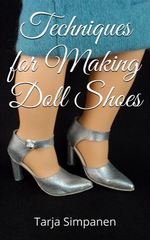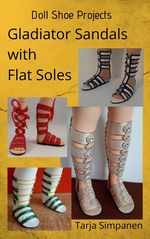I am making a universal master, a sole that is the same for left and right foot, because this is difficult enough without having to try to make two pieces that are mirror images of each other.
First I carved the heel out of fairly hard wood. I often use balsa wood for making a master, but it was too fragile for this purpose.

Then I made the sole out of several layers of cardboard. The colors do not matter when making a master, only the shape.

Next, I glued the heel in place. I used PVA glue as always and this time there was a good reason to do so, as you will soon see.

I shaped the upper part of the heel using polymer clay. This is why PVA glue is a good idea. As the master consists only of wood, carboard, PVA glue and polymer clay, you can bake it in the oven. I'm not sure what would happen with other kinds of glue, but PVA can take 130 degrees Celsius easily. On the background, you can see a couple of other masters for Sybarite's shoe soles.

Here is the master with a plaster casting of Sybarite's foot. I must say I'm fairly pleased with the result so far. Of course the master still needs painting and light sanding before it is ready. The surface needs to be perfect, or as close to it as possible, because each sole cast with the mould will be an exact copy of the master.

It will take some time before I get to the actual mould making, because I need to make several masters for various dolls before that. Making the moulds is time consuming and a bit messy, so I prefer to do several moulds in a batch.
Currently, I have a couple of masters for Silkstone Barbie and several for Pullip, although they also need painting and sanding. I decided to try these, because all other ways of making soles for Barbie or Pullip shoes are more difficult.
Finnish post is here.





7 comments:
Fantastic information! Thank you for sharing the pictures and videos! I keep checking to see what you have made and can't wait to see how your molded shoes turn out!
I'm a bit scared about the whole process. I've done it only once before and with different mould silicone than what I've got now. I'll probably start with the Pullip shoe soles to see how the silicone works.
Im really curious to see how everything turns out. I tried doing this for a misaki foot. I love heels and she has a flat foot. I tried using Rapid Prototyping though, with 3d software and printing onto plastic. I was told her feet were too small to use the software with or that I was taking a chance cause with such a thin heel like I wanted, it might fall apart easily.
Good luck!! Maybe this will inspire me to finally make some hot stripper heels for my misakis!
Thanks for sharing. It helped me make my own doll shoes. ^_^
Thank you! Yours is the first site I have seen that actually shows how-to. Awesome! Cindy, TX
Hi amazing idea. Have You ever tried Polystyrene (aka Styrene - scale modelers' plastic) & modelers glue which bonds to it by micro "melting" surface of pieces together and is seamless. It's also a thermoplastic..Just an idea!
Thank you so much, it's amazing work
Post a Comment